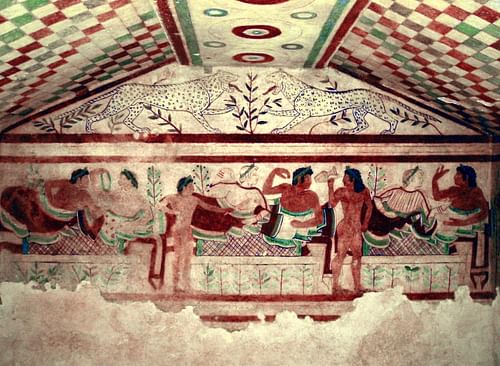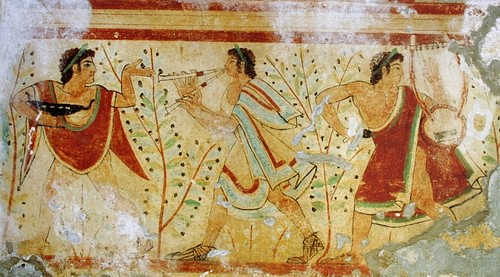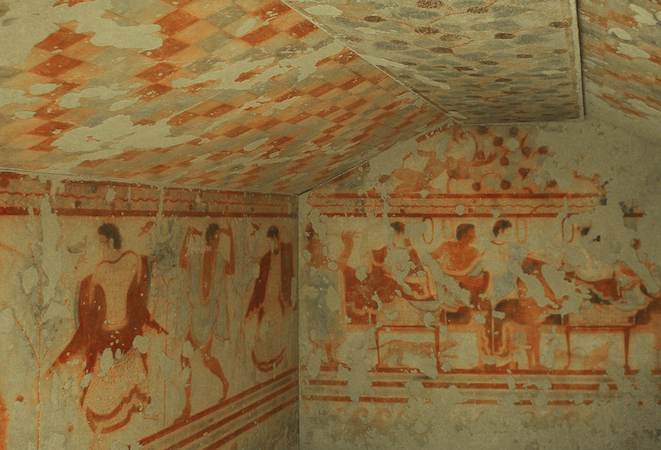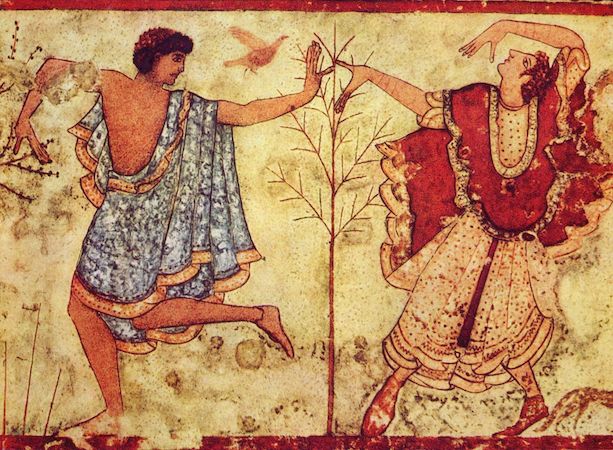Etruscan painting technique was characterized by painting directly on fresh plaster so that the paint adhered to the plaster and thusly became part of the wall itself. The paint used by the Etruscans was made of plants and organic matter.
Etruscan Tomb Paintings Ancient Man And His First Civilizations
Much of what we know about this civilisation is from the Etruscan tombs here in Tarquinia a short trip north of Rome.
. In the tombs carved into the stone the paintings were made using the tempera technique directly on the rock wall while the paintings found in houses were made as frescoes. Tombs were often highly decorated with details of funeral rites detailing funeral feasts and processions the gods of the underworld and the games used to commemorate the dead. The Etruscans usually placed their dead sometimes cremated sometimes not in subterranean tombs that contained sculptures and detailed painted murals.
Later techniques included those such as chiaroscuro which gives greater depth and value. The others are scattered across different cities and time periods. Some of the best examples of Etruscan painting are found in ancient tombs.
Leonardo therefore had access to Etruscan tombs from which to draw information about Etruscan funerary architecture. The scenes relate to Etruscan culture and society and show the inclusion of women in a symposium and a close connection to nature. Of those 140 are from Tarquinia.
From very early on the Etruscans were in contact with the Greek colonies in southern Italy. Many Etruscan sites primarily cemeteries and sanctuaries have been excavated notably at Veii Cerveteri Tarquinia Vulci and Vetulonia. Many surviving paintings are those on wall frescoes at burial sites.
Every level of Etruscan society had frescoes on their tombs. The blade in your razor should be replaced. Etruscan tomb paintings survive in a very narrow geography and context.
Within Etruscan art tomb painting is a special topic. Etruscan painting was highly developed and used pigments created from stone and minerals. They showed scenes of parties banquets ceremonies hunting sporting events important leaders and mythological figures or gods.
Fine arts in terracotta. Tomb interiors also contain much information about Etruscan life. Seen on sarcophagi and tomb paintings and Etruscan tombs are commonly likened to representations of banquets in non-funerary domestic buildings and tombs are often contexts as elucidated above indicates that the conceived of in scholarship.
Footnote 83 Indeed scholars have long recognized that Etruscan urns were known in fifteenth-century Italy and very likely earlier as well and all of them had to come from a tomb at one point or another. This floor was my personal favorite because of the interesting drawings on the potteries. Numerous Etruscan tomb paintings portray in vivid color many different scenes of life death and myth.
Tomb paintings Etruscan were funeral rites or optimistic scenes of aristocratic pleasures of----- Tomb of the Augurs in Tarquinia The figures stand on a horizontal ground line flanking the closed door leading to the underworld. This shows that these roofs might corroboration between the banqueting motifs equally be compared to domestic structures. The art treasures of the Etruscans Fine arts in terracotta.
In the southern part of the Etruscan empire most tombs housed sarcophagi while. Most of the potteries were however Greek in origin that were taken by the Etruscan and put in their tombs. Fight between Achilles and Troilus Etruscan fresco from the Tomb of the Bulls in Tarquinia Italy VI century BCE.
A considerable group of Etruscan tomb-paintings dating from the middle of the sixth century show in their composition close connexion with Ionic vase-painting especially with the so-called Caeretan hydriae while their main pictures tell us something about the Etruscans themselves and their conceptions of Life and Death and Eternity. Etruscan paintings were colorful and full of life. The Etruscans were isolated from other cultures.
Figure that looked like a red blob in a 2500-year-old Etruscan tomb painting is revealed Scientists using a new technique have uncovered the colorful and once-hidden scenes in paintings of the ancient Etruscans a group of people who flourished on the Italian peninsula around 2500 years ago at a time before Rome became powerful. The third floor had a gorgeous view of the city and contained transferred Etruscan tombs and other objects found at the sites. Tomb paintings suggest that gladiatorial contests could have had their origin in these funeral games.
The Tomb of Hunting and Fishing and the Tomb of the Leopards depict typical Etruscan funerary imagery in a common Etruscan painting style. The Etruscan tombs in Tarquinia. Within many of them are intricately painted wall frescoes which show us an insight into.
In the southern part of the Etruscan empire most tombs housed sarcophagi while urns were usually used in the northern part. Only in the animal friezes. About 180 Etruscan paintings are known.
Most remains of Etruscan funerary art have been found in excavations of cemeteries as at Cerveteri Tarquinia Populonia Orvieto Vetulonia Norchia meaning that what we see of Etruscan art is primarily dominated by depictions of religion and in particular the funerary cult whether or not that is a true reflection of Etruscan art as a whole. Very few tomb paintings are found in the northern half of Etruria. The largest collection is in the Necropolis of Monterozzi which has about 6000 graves dating back from the 7 th century BC.
Etruscan Tomb Paintings Ancient Man And His First Civilizations

Etruscan Tomb Paintings World History Encyclopedia

Tarquinia World History Encyclopedia
Etruscan Tomb Paintings Ancient Man And His First Civilizations

The Story In Paintings Genocide And An Etruscan Tomb The Eclectic Light Company

Tomb Of The Triclinium Article Khan Academy
Etruscan Tomb Paintings Ancient Man And His First Civilizations

0 comments
Post a Comment